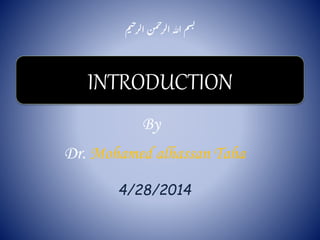Introduction to microbiology
- 1. ‫م‬‫ي‬‫ح‬‫الر‬ ‫من‬‫ح‬‫الر‬ ‫هللا‬‫م‬‫س‬‫ب‬ INTRODUCTION By Dr. Mohamed alhassan Taha 4/28/2014
- 2. What is MICROBIOLOGY?? •Very small to be seen by naked eye MICRO •LifeBIO •ScienceLOGY 4/28/2014 2Dr.Mohamed alhassan Taha
- 3.  Microbiology: Is the science that deals with the study of micro-organisms ;their activities and their influences on different aspects of life.  The term was introduced by the French chemist Louis Pasteur. What is MICROBIOLOGY?? 4/28/2014 3Dr.Mohamed alhassan Taha
- 4. • The organisms are widely distributed in nature. • Some of them are beneficial to man and some are harmful. • Medical microbiology deals with microbes that are harmful to man. 4/28/2014 4Dr.Mohamed alhassan Taha
- 5. The agents of human infections belong to Microbes Bacteria Viruses Fungi Parasites 4/28/2014 5Dr. Mohamed alhassan Taha
- 6. Bacteriology: is the science studying bacteria. Virology : is the science studying viruses. Mycology: is the science studying fungi. Parasitology: is the science studying parasites.  IMMUNOLOGY 4/28/2014 6Dr.Mohamed alhassan Taha
- 7. • Based upon cell characteristics, living organisms are recognized as having Eukaryotic or Prokaryotic cell type. 4/28/2014 7Dr.Mohamed alhassan Taha
- 8. Prokaryotes • They are small cells. • Don’t have a true nucleus, have anucleoid. • Have a single chromosome (DNA). • Have no nuclear membrane. • Have a small ribosomes (70S). • Reproduce by binary fission. • Have a rigid cell wall containing peptidoglycan. 4/28/2014 8Dr. Mohamed alhassan Taha
- 9. Eukaryotes • Have a true nucleus with a nucleolus surrounded by a nuclear membrane. • Contain organelles, such as mitochondria and lysomsomes. • Have multiple chromosomes. • Cell division is by mitosis or meiosis. • Ribosomes are large (80S). 4/28/2014 9Dr.Mohamed alhassan Taha
- 10. Characteristics of prokaryotic & eukaryotic cells Characteristic Prokaryote Eukaryote Size Relatively small Larger DNA content Nucleoid Nucleus Chromosome number One More than one Mitochondria Absent Present Nuclear membrane Absent Present Size of ribosomes 70S 80S Multiplication Binary division Mitotic Enzyme system Simple Complex 4/28/2014 10Dr. Mohamed alhassan Taha
- 11. • Bacteria belong to the prokaryote kingdom. • Fungi and parasites are members of eukaryote kingdom. • ?? viruses. 4/28/2014 11Dr.Mohamed alhassan Taha
- 12. Bacteria • Are prokaryotic cells, so: They are small and simple. Their genetic material is a single naked. chromosome without nuclear membrane. Surrounded by a rigid cell wall. They contain 70S ribosomes but no organelles, and replicate by binary fission. 4/28/2014 12Dr.Mohamed alhassan Taha
- 13. Fungi • Are eukaryotic cells with a complex cell wall (chitin). • Their cell membrane contains sterol. • Have chromosomes which are enclosed by a nuclear membrane and the cell contains ribosomes and mitochondria. • Exists as yeast, mold or both. • Reproduce typically by asexual and sexual mechanisms. 4/28/2014 13Dr.Mohamed alhassan Taha
- 14. Parasites • Are eukaryotics. • Either unicellular (protozoa) or multicellular helminths (worms). 4/28/2014 14Dr.Mohamed alhassan Taha
- 15. Viruses oAre not cells and not visible with the light microscope. oReplicate only in living cells and there for are obligate intracellular parasites. oContain NO organelles. oContain either DNA or RNA surrounded by a protein coat. 4/28/2014 15Dr.Mohamed alhassan Taha
- 16. Comparison of medically important organisms Characteristic Viruses Bacteria Fungi Protozoa helminthes Size( µ) 0,02 - 0.2 0.2- 5 3 -10 15 -20 (trophozoite) Nucleic acid DNA or RNA Both Both Both Nucleus None Prokaryotic Eukaryotic Eukaryotic Ribosomes Absent 70 S 80 S 80 S Mitochondria Absent Absent Present Present Nature of outer surface Protein capsid & lipoprotein envelope rigid wall containing peptidoglycan Rigid wall containing chitin Flexible membrane Motility None Some None Most Replication Not binary fission Binary fission Budding or mitosis Mitosis 4/28/2014 16Dr.Mohamed alhassan Taha
- 17. Antoni Van Leeuwenhoek First observed live microorganisms 4/28/2014 17Dr.Mohamed alhassan Taha
- 18. Louis Pasteur (1822-1895) The father of Modern Microbiology 4/28/2014 18Dr.Mohamed alhassan Taha
- 19. • Discovered and cultured the bacteria that cases T.B. • He laid Koch's postulates. 4/28/2014 Dr.Mohamed alhassan Taha 19 Robert Koch (1843- 1910)
- 20. ‫سينا‬ ‫ابن‬ (980-1037) 4/28/2014 20Dr.Mohamed alhassan Taha
- 21. 4/28/2014 Dr.Mohamed alhassan Taha





















